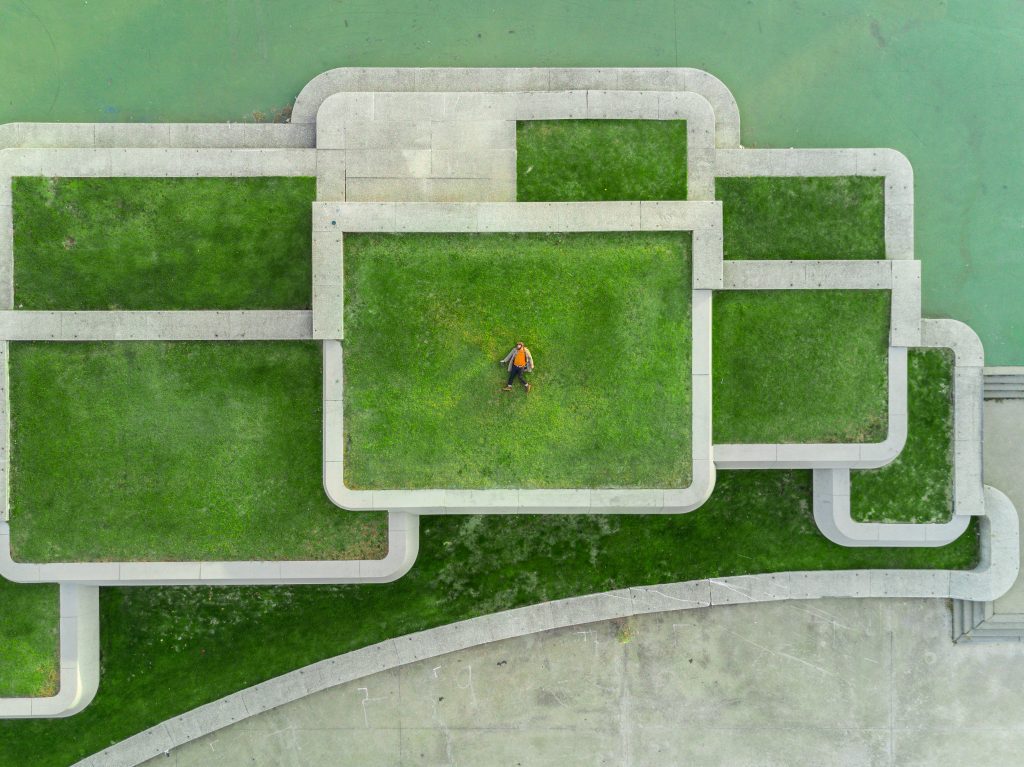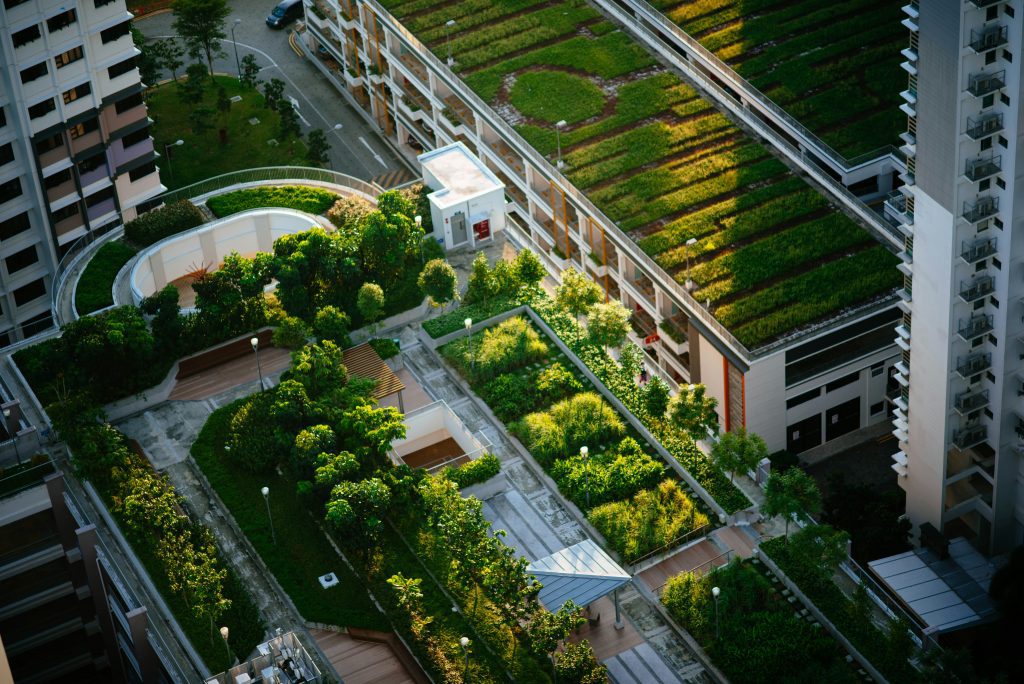Green roofing is a sustainable and environmentally friendly roofing system that offers a wide range of benefits. Firstly, green roofs provide natural insulation, reducing the need for artificial heating and cooling, which in turn lowers energy costs and reduces carbon emissions. This natural insulation also helps to regulate indoor temperatures, creating a more comfortable living or working environment.
Additionally, green roofs can help to mitigate the urban heat island effect by absorbing and reflecting heat, which can lower the overall temperature of urban areas. Furthermore, green roofs can improve air quality by capturing airborne pollutants and carbon dioxide, whilst also releasing oxygen into the atmosphere. This can have a positive impact on public health, particularly in densely populated urban areas.
Green roofs also help to manage stormwater runoff by absorbing and filtering rainwater, reducing the strain on drainage systems and minimising the risk of flooding. In addition to these environmental benefits, green roofs can also provide habitats for wildlife, promote biodiversity, and create green spaces for relaxation and recreation in urban areas. Green roofing systems offer a multitude of benefits, including natural insulation, improved air quality, stormwater management, and the creation of green spaces in urban areas.
These systems have the potential to significantly reduce energy costs, lower carbon emissions, and mitigate the urban heat island effect. Additionally, green roofs can provide habitats for wildlife and promote biodiversity, whilst also creating green spaces for relaxation and recreation in urban areas. Overall, green roofing is a sustainable and environmentally friendly roofing system that offers a wide range of benefits for both the environment and the community.
Summary
- Green roofing provides insulation, reduces energy costs, and improves air quality
- Extensive green roofing systems are lightweight, low maintenance, and suitable for shallow-rooted plants
- Intensive green roofing systems support a wider variety of plants and require more maintenance
- Urban agriculture on green roofs can provide food, reduce urban heat island effect, and manage stormwater
- Biodiverse green roofing systems support a wide range of plant and animal species, promoting biodiversity
- Green roofing can reduce stormwater runoff, extend roof lifespan, and improve urban air quality
- Green roofing can be integrated into sustainable building design to enhance energy efficiency and environmental sustainability
Exploring Extensive Green Roofing Systems
Environmental Benefits
In addition to their environmental benefits, extensive green roofs can also extend the lifespan of the underlying roof membrane by protecting it from UV radiation and extreme temperature fluctuations. Furthermore, these systems can help to reduce noise pollution by absorbing and insulating sound, creating a quieter indoor environment.
Cost-Effectiveness
Extensive green roofs are also cost-effective, as they require minimal maintenance and can help to lower energy costs by providing natural insulation.
Ideal for Urban Areas
Overall, extensive green roofing systems are lightweight, low-maintenance, and cost-effective. They are ideal for buildings with limited load-bearing capacity or accessibility and can thrive in harsh environmental conditions due to their shallow soil depth. These systems offer a range of environmental benefits, including the reduction of stormwater runoff, improved air quality, and the creation of green spaces in urban areas. Additionally, extensive green roofs can extend the lifespan of the underlying roof membrane, reduce noise pollution, and lower energy costs through natural insulation.
Delving into Intensive Green Roofing Systems

Intensive green roofing systems are more complex and versatile than extensive systems, as they typically feature a deeper soil layer and a wider variety of vegetation. These systems can support a diverse range of plants, including trees, shrubs, and even vegetable gardens, creating a more traditional garden space on the roof. Intensive green roofs require more maintenance and irrigation than extensive systems but offer greater opportunities for biodiversity and urban agriculture.
In addition to their environmental benefits, intensive green roofs can provide valuable outdoor space for residents or employees, promoting health and wellbeing in urban environments. These systems can also improve the aesthetic appeal of buildings and contribute to a sense of community by creating shared green spaces. Furthermore, intensive green roofs can help to reduce the urban heat island effect by providing additional shade and cooling effects through evapotranspiration.
Overall, intensive green roofing systems are more complex and versatile than extensive systems, offering greater opportunities for biodiversity and urban agriculture. These systems can support a diverse range of plants, including trees, shrubs, and vegetable gardens, creating valuable outdoor space for residents or employees. In addition to their environmental benefits, intensive green roofs can improve the aesthetic appeal of buildings, contribute to a sense of community, and help to reduce the urban heat island effect through additional shade and cooling effects.
Investigating the Use of Urban Agriculture in Green Roofing
| City | Number of Green Roofs | Area of Urban Agriculture | Percentage of Green Roofs with Agriculture |
|---|---|---|---|
| London | 150 | 5000 sqm | 30% |
| Manchester | 80 | 3000 sqm | 25% |
| Birmingham | 120 | 4000 sqm | 35% |
Urban agriculture on green roofs is an innovative approach that has gained popularity in recent years due to its numerous benefits. By utilising the space on rooftops for growing food crops, urban agriculture can contribute to food security in densely populated urban areas. This practice also promotes local food production and reduces the carbon footprint associated with transporting food from rural areas to cities.
Furthermore, urban agriculture on green roofs can help to mitigate the urban heat island effect by providing additional shade and cooling effects through evapotranspiration. This can lower the overall temperature of urban areas and create a more comfortable living or working environment. Additionally, growing food on rooftops can improve air quality by capturing carbon dioxide and releasing oxygen into the atmosphere while also providing habitats for pollinators and other beneficial insects.
In conclusion, urban agriculture on green roofs is an innovative approach that can contribute to food security in urban areas while promoting local food production and reducing carbon emissions associated with food transportation. This practice also helps to mitigate the urban heat island effect by providing additional shade and cooling effects through evapotranspiration while improving air quality and providing habitats for wildlife.
Examining Biodiverse Green Roofing Systems
Biodiverse green roofing systems are designed to support a wide range of plant species and provide habitats for wildlife in urban environments. These systems typically feature a diverse mix of native plants that attract pollinators such as bees and butterflies while also providing food and shelter for birds and other small animals. Biodiverse green roofs can contribute to urban biodiversity conservation efforts by creating valuable habitats in densely populated areas.
In addition to their environmental benefits, biodiverse green roofing systems can improve air quality by capturing airborne pollutants and carbon dioxide while releasing oxygen into the atmosphere. These systems also help to manage stormwater runoff by absorbing and filtering rainwater, reducing the strain on drainage systems and minimising the risk of flooding. Furthermore, biodiverse green roofs can contribute to the aesthetic appeal of buildings by creating visually appealing natural landscapes in urban areas.
Overall, biodiverse green roofing systems are designed to support a wide range of plant species and provide habitats for wildlife in urban environments. These systems contribute to urban biodiversity conservation efforts by creating valuable habitats in densely populated areas while improving air quality and managing stormwater runoff. Additionally, biodiverse green roofs can contribute to the aesthetic appeal of buildings by creating visually appealing natural landscapes in urban areas.
Considering the Economic and Environmental Impacts of Green Roofing

Economic Benefits
From an economic perspective, green roofs can extend the lifespan of the underlying roof membrane by protecting it from UV radiation and extreme temperature fluctuations. This can result in lower maintenance costs and reduced need for roof replacements over time.
Energy Efficiency
Furthermore, green roofs can help to lower energy costs by providing natural insulation and reducing the need for artificial heating and cooling. This can result in significant savings on energy bills for building owners or tenants.
Environmental Advantages
From an environmental perspective, green roofs can mitigate the urban heat island effect by absorbing and reflecting heat, which can lower the overall temperature of urban areas. Additionally, these systems can improve air quality by capturing airborne pollutants and carbon dioxide while releasing oxygen into the atmosphere.
In conclusion, green roofing systems offer a range of economic and environmental benefits that make them an attractive option for sustainable building design. These systems can extend the lifespan of roof membranes, lower energy costs through natural insulation, mitigate the urban heat island effect, and improve air quality in urban areas.
Implementing Green Roofing in Sustainable Building Design
Green roofing is an integral component of sustainable building design that offers a wide range of benefits for both the environment and building occupants. By incorporating green roofs into building designs, architects and developers can create more energy-efficient structures that contribute to lower carbon emissions and improved air quality in urban areas. Green roofs also provide valuable outdoor space for residents or employees, promoting health and wellbeing in densely populated environments.
Furthermore, green roofing systems can help to manage stormwater runoff by absorbing and filtering rainwater, reducing the strain on drainage systems and minimising the risk of flooding. This practice contributes to more resilient urban infrastructure that is better equipped to handle extreme weather events associated with climate change. Additionally, green roofs can provide habitats for wildlife and promote biodiversity conservation efforts in urban areas.
In conclusion, implementing green roofing in sustainable building design is an effective way to create more energy-efficient structures that contribute to lower carbon emissions and improved air quality in urban areas. Green roofs also provide valuable outdoor space for residents or employees while helping to manage stormwater runoff and promoting biodiversity conservation efforts. Overall, green roofing is an integral component of sustainable building design that offers a wide range of benefits for both the environment and building occupants.
If you’re interested in sustainable home improvements, you may also want to check out this article on the most eco-friendly boiler options for your home. It provides valuable information on how to make your home more environmentally friendly by choosing the right boiler. Just like green roofing, eco-friendly boilers can help reduce your carbon footprint and contribute to a more sustainable future.
FAQs
What are the different types of green roofing?
There are several types of green roofing, including intensive green roofs, extensive green roofs, and semi-intensive green roofs. Each type has different levels of maintenance and plant diversity.
What is an intensive green roof?
An intensive green roof is a type of green roofing that has a deeper growing medium, allowing for a wider variety of plants, including trees and shrubs. These roofs require more maintenance and can support a greater diversity of plant life.
What is an extensive green roof?
An extensive green roof is a type of green roofing that has a shallow growing medium and is typically planted with low-maintenance, drought-resistant plants. These roofs require minimal maintenance and are lighter in weight than intensive green roofs.
What is a semi-intensive green roof?
A semi-intensive green roof is a type of green roofing that falls between intensive and extensive green roofs in terms of plant diversity and maintenance requirements. These roofs typically have a medium-depth growing medium and can support a variety of plant types.
What are the benefits of green roofing?
Green roofing provides numerous benefits, including improved air quality, reduced urban heat island effect, stormwater management, and energy savings. Additionally, green roofs can extend the lifespan of the roof membrane and provide habitat for wildlife.


